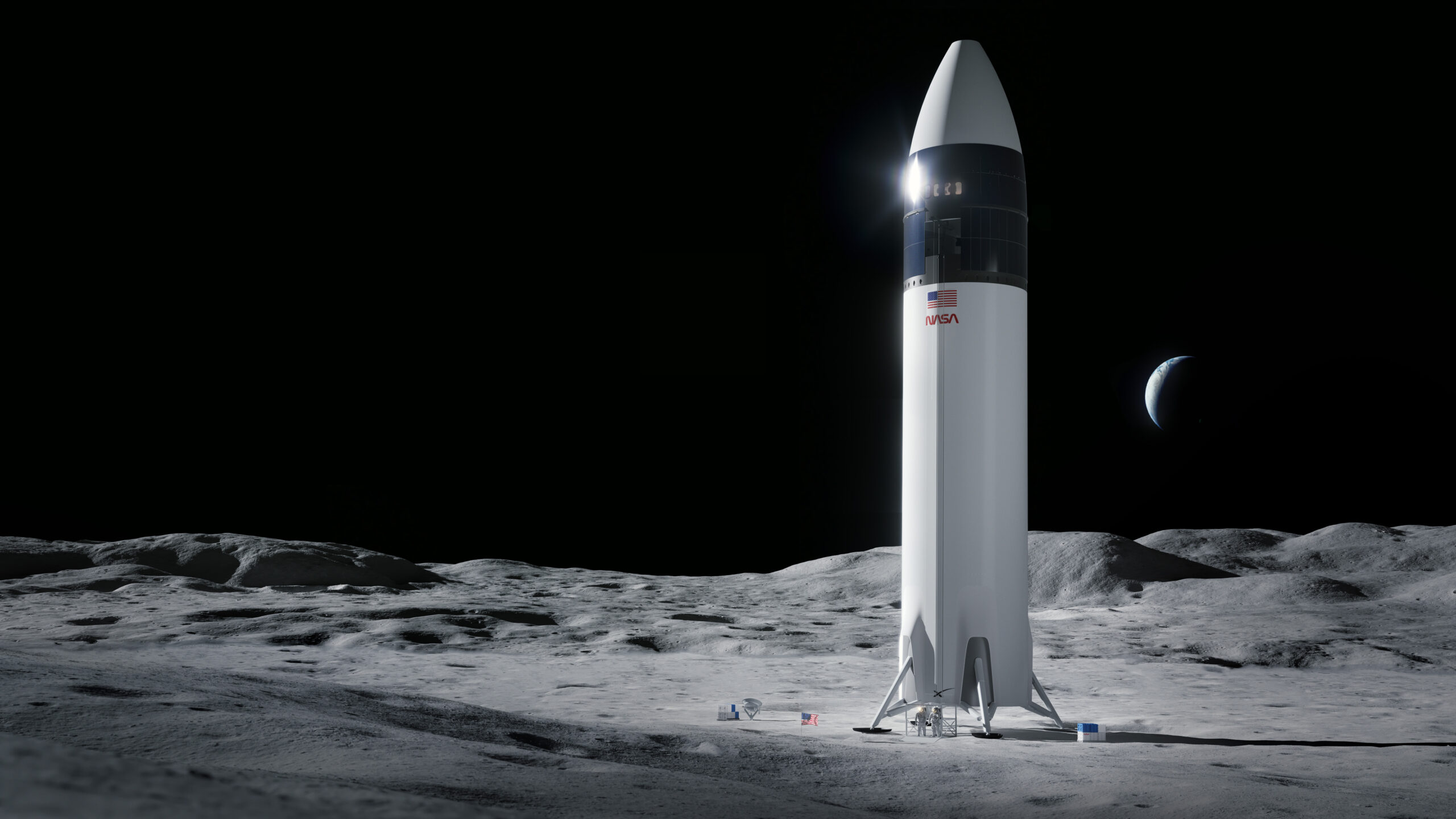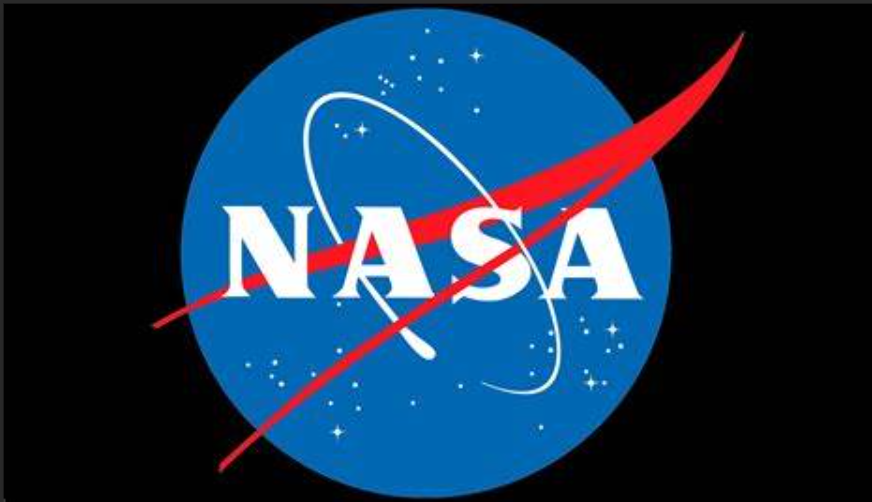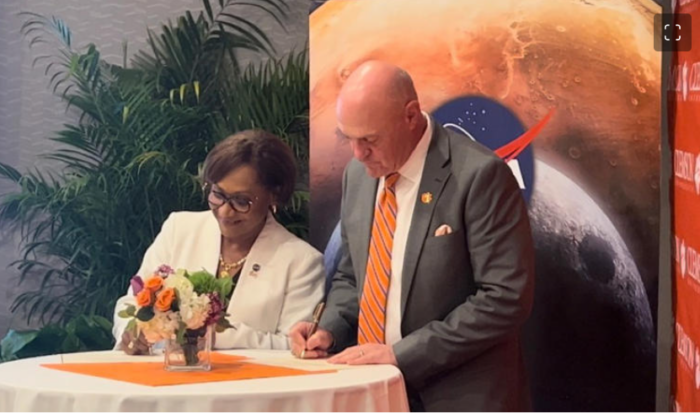by Julia Seibert
51 years ago, mankind left the moon and never looked back. NASA had won the Space Race, the US had proven its point, and there were more urgent Earthly matters for its government to address instead of spending billions exploring our bleak, desolate satellite. Today, however, US lunar ambitions are experiencing a half-hearted renaissance. Despite little public support, geopolitical competition and the need for a large-scale NASA program to replace the Space Shuttle have resulted in Artemis: NASA’s return to the moon.
The agency is a little out of practice when it comes to landing humans on the moon – half a century, to be exact. NASA, fearing (even more) cost overruns, sluggishness, and political backlash, therefore turned to a group of commercial space companies to design and develop its Human Landing System (HLS). The move is part of a broader shift towards the commercialization of space, signaling that the US means business on the moon – in more ways than one.
In this article, we will refer to the ‘Human Landing System’ as HLS.
Table of Contents
ToggleWhat is a Human Landing System (HLS)?
The Human Landing System (HLS) is NASA’s mode of transportation to get astronauts to the Moon as part of the Artemis program. This mission will include the first woman and the first person of color to land on the lunar surface.
It is being designed and developed by US commercial companies, which is no coincidence; landing on the moon, so the agency, is the most ‘difficult and dangerous’ part of the whole mission. Commercial outsourcing, a method that NASA has been cultivating for the past few decades, helps soften the blow of this risk in several ways.
Firstly, it can save the agency a good chunk of money. Contracting a company to design and develop a project of this scale by means of a few fixed-price contracts is significantly cheaper than NASA taking over the brunt of the work. It is also less politically costly. Companies can afford to mess around with riskier, newfangled tech – which means a bumpier development process – outside of the political spotlight, while NASA must keep a squeaky-clean image. Using private resources for matters relatively unpopular with the public but important to the government – like going back to the moon – is a way to mitigate public backlash while pursuing these goals at a lower cost. Also, with fewer checks to go through, companies can speed up the products’ development, which ultimately makes NASA look better. On the flip side, it means that if something were to go wrong with the landing, NASA has someone to pin the blame on.
Competition for Designing the HLS
The commercial HLS project commenced in 2019 when the agency put out a call for company proposals. Of the five companies who responded – SpaceX, Blue Origin, Dynetics, Boeing, and Vivace – NASA ended up picking SpaceX, Blue Origin, and Dynetics for the next stage of the process. Here, each company received a healthy sum to develop their designs over a 10-month period, after which further cuts would be made. After delaying the decision for two months, NASA decided solely on SpaceX’s design – a modified version of its Starship rocket – and awarded the company about US $2.9 billion. The money would go towards further development of the rocket as well as two flights: one to test out the vehicle, and one to finally land humans on the moon for the Artemis III mission.
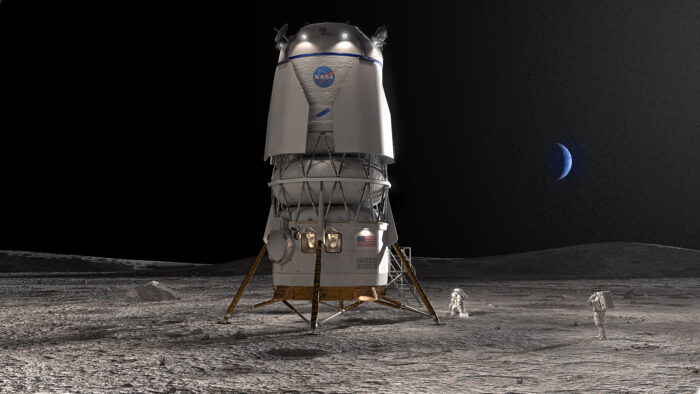
Not everyone was happy with the decision. Blue Origin, after protests to the Government Accountability Office (GAO) failed, sued NASA, claiming that choosing SpaceX as the sole winner was unfair. The lawsuit, which was ultimately rejected, delayed Starship development by several months, also earning the company the nickname ‘Sue Origin’. Still, the latter need not have bothered; though SpaceX would go on to win an additional US $1.15 billion to provide a landing for Artemis IV, Blue Origin in May 2023 snapped up a US $3.4 billion contract for its new lander design, to be used for Artemis V.
The HLS in Artemis Missions
The HLS would bring humans from lunar orbit to the surface and back. It would also help construct and dock to Gateway, the planned lunar space station that will serve as a short-term habitation module and scientific research hub. Since the first Gateway module is planned to arrive in lunar orbit between Artemis III and IV, the first few HLS missions will see the vehicle docking directly to the Orion spacecraft, which ferries the astronauts to lunar orbit from Earth. From there, it will land on the moon and serve as a home for astronauts as they conduct their research and scour for resources. After the preliminary mission, the vehicles are tasked with landing more crew and payload with the aim of ‘establishing a long-term human presence under Artemis’.
Features & Design of HLS
So far, two designs have been chosen for the HLS of the Artemis program. The first is SpaceX’s proposal, a modified version of its prototypical Starship rocket and the second one is Blue Origin’s innovative design.
The HLS Starship consists of the second stage of the two-stage, fully reusable rocket system; it would stand 50 meters tall and 9 meters wide. The crew cabin would be in the payload bay, located on the upper half of the rocket, with the lower half holding its liquid oxygen and methane propellants. It would be powered by six Raptor engines (like its Earthly twin) but would swap its fins used for atmospheric entry on Earth – useless in the lunar near-vacuum – for landing legs. The official artist’s rendition of the vehicle also depicts the lander wrapped in solar panels. The payload bay has a volume of 1,000m3, and the rocket is advertised as being capable of carrying over 100 metric tons to the lunar surface. To do that, however, the vehicle must refuel several times in orbit; this requires a handful of tanker Starships that would fill a fuel depot Starship waiting in orbit, which would then refuel the HLS after its launch.
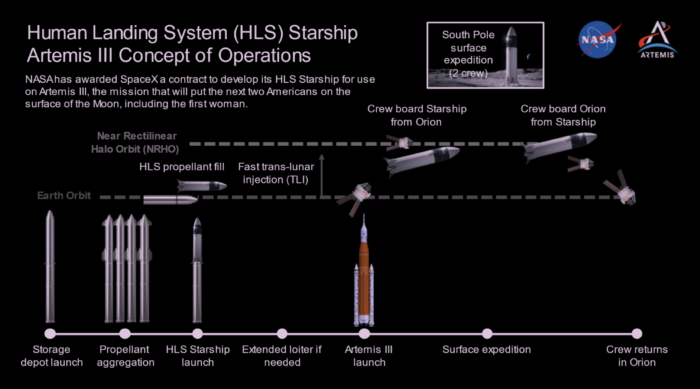
Blue Origin’s HLS design is quite different. It has little to do with the initial proposal rejected by NASA in 2021 and costs a good amount less. The lander is 16 meters tall, though it could squeeze into the 7-meter payload bay of the company’s still-nonexistent New Glenn rocket. The lander would be capable of bringing 20 metric tons to the lunar surface while remaining reusable (30 if left on the lunar surface). It runs on liquid hydrogen and oxygen, which – as opposed to Starship – are located on the upper half of the vehicle, with the crew cabin at the bottom. The design calls for cooperative efforts from a number of outside companies. Lockheed Martin, for example, will provide an orbital refueling vehicle, while other companies will handle systems such as docking, navigation, control, and cargo offloading.
Read also also:
Objectives and Goals of NASA’s HLS
For the near future, the HLS has just one goal: to enable crewed missions on the moon. Early missions will simply require a vehicle to provide transportation to and from the surface. It would also serve as a temporary home for the few days the astronauts spend on the surface, enabling them to fulfill their scientific duties and shield them from radiation. As mission profiles develop, the HLS’s role will expand. NASA is setting its sights on long-duration missions and even first attempts at colonization and local resource utilization, which means tons of material must be shelved from Earth to the moon. That might include preliminary infrastructure for a permanent lunar habitat and machines to be used for mining and resource processing.
NASA is already supporting the first commercial efforts regarding space habitat manufacturing and lunar power systems. The agency has already contracted several commercial companies for non-human lunar transportation under its Commercial Lunar Payload Services (CLPS), but bigger infrastructure may not fit within these smaller lander designs. The HLS could help with this, and bring many more astronauts to the moon as mining and colonization efforts begin.
See also: How are we going to colonize the Moon?
Planned Missions and Timeline
Timelines for the Artemis program have been, and still are, notoriously nebulous and prone to delays. Artemis I (a test of the SLS rocket and Orion spacecraft) successfully took off in November 2022 after almost six years of delays. Artemis II (a crewed lunar flyby) is slated for 2024, and Artemis III (the first landing) is planned for 2025, though delays might cause these dates to slip. The HLS complicates matters further, as SpaceX’s Starship has flown exactly once and, so far, has a 100% explosion rate.
Considering the technological advancements featured on Starship and SpaceX’s way of developing these – blowing up prototypes to iterate faster – the fiery display is not surprising. It does, however, call into question how soon the rocket will be ready to perform several orbital rendezvouses and safely carry crew. With a 2024 lunar test flight looking less probable by the day, SpaceX might well miss its 2025 landing date, and NASA knows it. If that happens, says Jim Free, Associate Administrator for exploration systems development, the mission might go ahead without a lunar landing, or the launch could be pushed to 2026 (already a burgeoning possibility considering the complexity of the mission).
How this dilemma plays out will affect Artemis IV, another landing mission scheduled for 2028. By then, the first modules of the Gateway station should be in orbit (currently set to launch in 2025), and the first power and construction demonstrations will have taken place. The fourth Artemis mission would involve building out the station and docking it with Orion and the Starship HLS; the latter would also be used for a crewed landing.
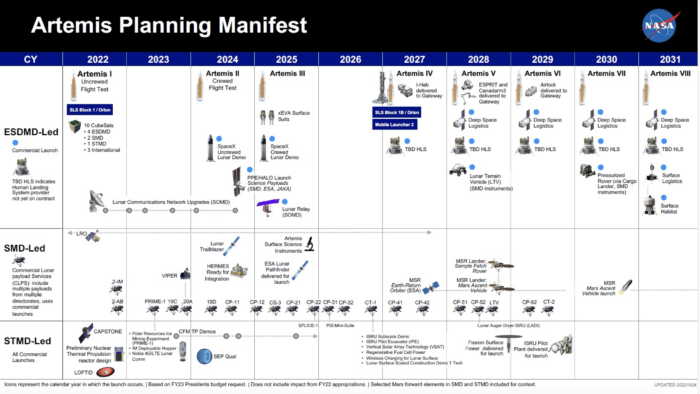
Next up is Artemis V, to launch in 2029. Like its predecessor, its objective is further Gateway construction and another crewed landing, this time with Blue Origin’s lander (which would have completed its test a year prior). It would also have astronauts driving around the moon in a buggy, or Lunar Terrain Vehicle.
The next few Artemis missions, scheduled to launch once a year, have no set HLS yet and have vaguer objectives. So far, these involve completing Gateway, having astronauts speed around in Toyota and JAXA’s pressurized Lunar Cruiser, and laying the groundwork for long-duration missions and colonization.
Challenges and Risks in HLS Development
HLS development is not without its hardships, especially since the prime candidates utilize plenty of novel, untested technology. This is necessary for the mission’s demands, but can cause delays and even changes to future missions, as seen already with SpaceX. As noted by the GAO, most of the technologies offered by HLS commercial contractors are not yet fully developed; a report by the office deemed that only four out of 11 ‘critical technologies’ proposed by the contractors were ‘mature’.
All that modern tech and its testing is causing delays, to which a host of other factors have also contributed. The recent pandemic, the 7-month Blue Origin lawsuit that halted Starship development, and delayed (and insufficient) funding have all hampered the progress of an HLS, so NASA. It does not help that the program is under a stringent timeline, with a lunar landing initially scheduled for 2024; aligning new, unpredictable technology with a strict deadline set by politicians was never going to be a complete success.
The biggest risk of all, though, happens once development finishes and the actual missions commence. Several lives will depend on the HLS during the most perilous part of the mission, and the systems will have had little in-situ testing by the time they carry humans. The challenge comes in balancing the speed of development and adherence to timelines against the safety and reliability of this untried tech, which is easier said than done.
You may also like:
- Top 6 SpaceX’s Goals and Objectives
- How much does it cost to launch a rocket?
- 20 Best Space Movies to Watch in 2023
Conclusion
It might seem like a return to the 1960s, a blast from the past – but there is more to the US’s modern lunar ambitions than meets the eye. The outsourcing of the HLS is significant as it marks the first major case of outsourcing deep space exploration. It presents certain benefits to NASA – lower costs, less direct accountability – but also sets the stage for a commercial lunar industry and economy.
The Human Landing System (as well as other lunar technologies undergoing commercialization, such as power systems, construction, and in-situ resource utilization) could allow companies to pursue their own goals alongside NASA. By investing in HLS proposals that require the use of powerful, (at least partially) reusable rockets like Starship Superheavy and New Glenn, NASA can keep its Congress-mandated SLS rocket while simultaneously spurring the next generation of heavy-lifters that will dwarf most other efforts. The US has recognized that while commercial companies may not always go hand in hand with the agency’s ambitions, they help to further the US’s dominance in space. So as NASA’s Artemis program slowly kicks into gear, its side effect – a commercial lunar presence – might have been the real prize all along.
If you found this article to be informative, you can explore more current space news, exclusives, interviews, and podcasts here.
Featured image: Artist’s concept of SpaceX Starship human landing system. Credit: SpaceX
Share this article:
